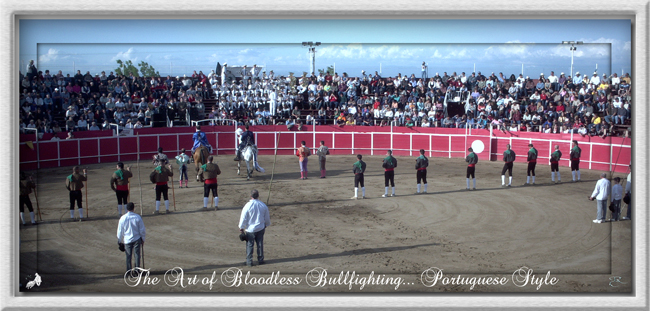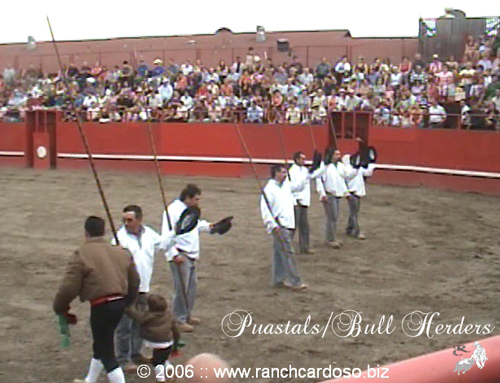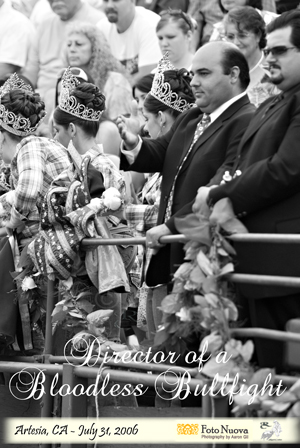
Portuguese Style Bloodless Bullfighting in California
Bloodless bullfighting is a style of bullfighting which
originated in Portugal and
adjusted to accommodate the laws of the United States.
Unlike the classical Spanish style bullfight,
the Portuguese-style bullfighting (also
known as Portuguese tourada, corrida de touros or tauromaquia) in Portugal,
does not involve killing of the bulls in the arena, but some blood is drawn
to slow the bull down.
Bloodless bullfighting in California is
Portuguese-style. Artful and yet skillful, bloodless bullfighting
evolved so that the Portuguese people can enjoy part of their heritage and
culture in the United States.
The difference between bloodless bullfighting in California,
and the bullfighting in Portugal is
the use of hook and loop fasteners. To keep this sport "bloodless", one inventive
Portuguese came up with the idea of using "Velcro". A large piece of Velcro
is placed on the back of the bull, while the other end is placed at the tip
of the banderillas, a long stick/spear, with tassles or some kind of a decoration
around it. This mechanism replaced the banderillas which possessed the 3-inch
nails/barb used in the classic Spanish style of bullfighting. In Portugal,
they use the banderillas, but with smaller nails/barb to slow the bull down.
1 History
There is some history about Portuguese bullfights. One influential deciding
factor for not killing bulls in Portuguese bullfights was the Battle of Salga,
on the island of Terceires. This battle, also known as the Battle of the Bloody
Sea, occurred on July 5, 1581, when a fleet of ten Spanish ships anchored
off the shore of Terceira. Early in the morning on July 20, the Spanish sent
their army in to invade. About mid-day, as the fighting still seemed indecisive
a friar named Pedro thought of the idea of driving a 1000 wild cattle toward
the Spanish lines. The strategy was a success, driving the Spanish back to
the beach in an attempt to reach their ships. Almost all of the invaders were
killed or drowned in their attempt to flee, hence the name Battle of the Bloody
Sea.
Much later, in 1836, Portugal deemed the killing of bulls to be immoral,
and passed a law banning the public killing of bulls. However, this law only
lasted one year. The second time a law was passed prohibiting the public killing
of bulls was in 1928.
Death bullfights were made legal again in 2002 by the Portuguese Parliament,
saying that it has been a social tradition. In the past, when the Portuguese
government deemed it illegal to kill the bulls, there was a great social outcry
to legalize it again. In 2002, there was again a social outcry, but this time
to keep illegal the killing of the bulls.
The tradition of bullfighting (corrida) originated in ancient times as a
pastime of cattle-drivers, similarly as the rodeo of american cowboys. It
was so immensely popular that it became the Spanish national sport. Its tradition
is alive to the present days.
2 Opening ceremony
Opening ceremony of a Portuguese style bloodless
bullfight in California
The ceremony (called the cortesias in Portuguese) starts with all of the
performers and participants entering the arena, including the bandaleiros
(helpers) and Pustals (bull herders), with the sounds of a Filarmonica (band),
playing a march or a paso doble.
Here is the order of entrance during the ceremony, as well as the fundamentals
of a Portuguese style bloodless bullfight:
2.1 Forcados
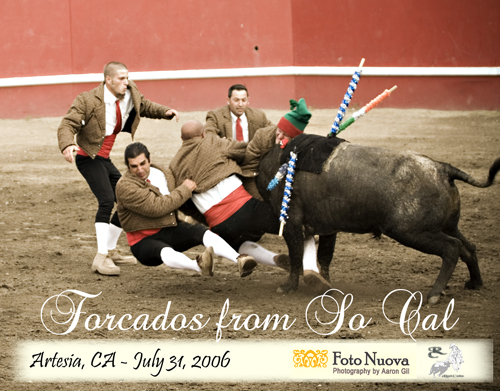
Forcados do Sul de California attempting to grab the bull
- First are the Forcados... eight men who line up in the middle
of the arena to grab the bull while it is charging towards them. The
front man calls out to the bull, getting its attention to charge towards
him, to perform a pega de cara or pega de caras (face catch). The front
man secures himself on top of the animal's head and is quickly aided
by his fellows who surround and secure the animal until he is subdued.
- The name forcado in Portuguese means "pitchfork" (a long stick with
a u-shape steel at the top), which the forcados use to carry in their
hands when appearing in the arena. Traditionally, the pitchfork was used
to help ward off the bull from the king and queen.
- The Forcados wear a costume similar to the style of a matador, but
are not flashy and as decorative and bright. They wear a black knee pants,
bolero style jacket with slits in the armpits (for movement), white socks,
brown leather shoes, and a green & red hat (looking almost like an
elf's hat). They also carry with them a pitchfork inside the arena during
the opening ceremony only and not while they grab the bull.
- Forcados are not professionals like bullfighters, because there is
no formal training or certification to become one. Although, they take
their craft very seriously and everything must be done the traditional
way (from entering the arena to how the bull is grabbed).
- Modern day Forcados range from students to professionals.
2.2 Matadores
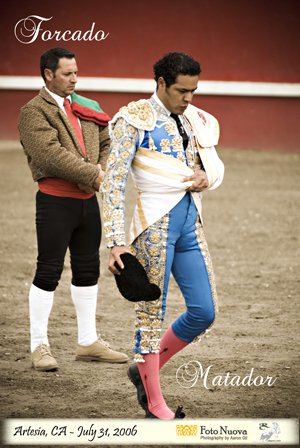
Matador Jose Luis Angelino
Then enters the Matadores (professional)
/ Novilleros (amateur), meaning "killer", and one that bullfights on foot.
These are the men wearing skin tight pants and a bolero jacket called a "Suit
of Light" (traje de luces), along with pink socks. Very similar to the Spanish
matadores and most who come are from Mexico.
- A professional bullfighter is
one who gets paid.
- A true Matador is one who takes their "alternativa" (a ceremony to
become a professional).
- Prior to being called a Matador,
an amateur bullfighter
is known as a Novillero (or a becerrista).
- The Suit of Light is the Matador's costume,
worn since the mid 18th
century.
- The garment is
made of silk with
intricate designs, and adorned with gold sequins.
- Anyone can wear the "Suit of Ligths", but it is frowned upon
by professionals and aficionados if
the person wearing it has not taken their alternativa. It's a "right
of passage".
- The Matador's assistants inside the arena are called "Banderilleros".
They are toreros, skilled like the Matadors, but they are not professionals.
- They wear the "Suit of Lights" called the pasa maria, made of
silk, but the adornments are in silver and not gold. The gold sequins
is reserved for a real Matador.
- The Banderilleros job is to strategically place the bull where
the Matador or the Cavaleiro tells them to. They also distract
the bull while the Matador or Cavaleiro position themselves in
the arena.
2.3 Puastal (bull herders)
- Then come the Puastal (bull herders), the men who bring the
bull from the pen to the arena. These are the people who work very closely
with the Ganadero (bull breeder) and they also do most of the preparation
of the bull before an event, like tying the leather wrap around the horns
(for the Cavaleiros and Forcados), and sometimes cutting/filing the pointy
tip of the horn for the Matadors. Then they place and glue the Velcro
on top of the bull's back.
They range from students to professionals.
2.4 Cavaleiros
Cavaleiro Vasco Taborda, Jr. with a black Lusitano
named Indio during an opening ceremony of a bloodless bullfight
- The Cavaleiros (rejoneadores in Spanish style), are the horsemen who
enters the ring mounted on magnificently trained horses. They are dressed
in a Portuguese-style costume that are the traditional 18th
century attire, while the Rejoneadors (Spanish-style) costume consist
of a bolero and leather chaps.
- They are the main performers of a Portuguese style
bullfight, exhibiting on horseback the
technical movements and the extraordinary ability of the horses, along
with their skill and bravery.
- Fighting on horseback is a central feature of Portuguese bullfighting.
- Horseback bullfighters are frequently members of old aristocratic
families
2.4.1 Cavalos
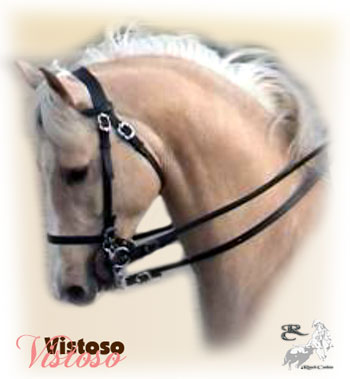
an Azteca horse (Quarter horse x Lusitano mix
breed)
- Centuries ago, Spanish Andalusians and Portuguese Lusitanos were
the only breed of horses used
and specially trained for the bullfights.
- These horses are usually skilled in dressage and display their art
in the arena.
- Movements of a Lusitano are not so strong and the back is a little
bit more flexible - that is the best part of the Lusitano and you can
sit on them better.
- Lusitanos are better at the high movements of dressage, piaffe,
passage, pirouettes and
not so good competing in the extended movements. In canter they are good,
they are wonderful with flying changes.
- In modern days, it is acceptable and common to crossbreed horses to
find the perfect breed and improve the performance of a bullfighting
horse. Other breeds include Arabians, Quarter
Horse, Aztecas,
and Thoroughbreds,
just to name a few.
- Here's a few examples of what breeders have
discovered as potential for cross breeding: Aztecas (Lusitano/Andalusian
x Quarter Horse), Anglo-Arabs (Thoroughbred x Arabians), and Arabs x
Lusitanos are just a few that are becoming well-known in the mainstream,
due to the strength and speed that each produces. This is also done because
the fighting bulls are becoming stronger and faster.
read
about Lusitano Sub-Breeds: [AlterReal
(AR)] �• �[Andrade] �• �[PSCN] �• �[Veiga]
2.5 End of opening ceremony
After everyone has made their way in and around the arena, one by one, they
go to the front and center of the ring, where they ceremoniously salute the
presiding official-the director of the bullfight, starting with the Cavaleiros
and ending with the Puastals (bull herders).
3 Bullfight
A typical bullfight has 6 scenes with 6 bulls, giving each performers 3 bulls
each. Usually, the line-up is listed as follows:
- Scene 1, Act 1, Bull 1: Cavaleiro
- Scene 1, Act 2, Bull 1: Forcados
- Scene 2, Act 1, Bull 2: Matador
- Scene 3, Act 1, Bull 3: Cavaleiro
- Scene 3, Act 2, Bull 3: Forcados
- Scene 4, Act 1, Bull 4: Matador
- Scene 5, Act 1, Bull 5: Cavaleiro
- Scene 5, Act 2, Bull 5: Forcados
- Scene 6, Act 1, Bull 6: Matador
Notice how the Cavaleiro's act is immediately followed by the Forcados without
changing bulls. Usually, the intermission occurs in between the 3rd and 4th
bull, allowing a 15-30 minute break for all of the performers and attendees
to either get something to eat or stretch their legs.
Once a bullfight is in session, it is with respect that the noise level is
kept at a minimum, and the audiences do not stand up or run around. Doing
so will distract the bull and could result in serious injuries to either the
performers or the crowds in the stands. It's not often, but it can happen,
where a bull will jump into the stands causing harm to people.
4 Filarm�nica (band)
The bands (Filarm�nica) provide traditional music during a bullfight.
Such styles include a Paso Dobles Taurinos, Marchas/Marches, and Pecas de
Concerto/ Concert Pieces. It can motivate the bullfighter to do better as
well as add excitement to the crowd [citation
needed].
5 Performances
5.1 Scene 1, Act 1: CAVALEIRO
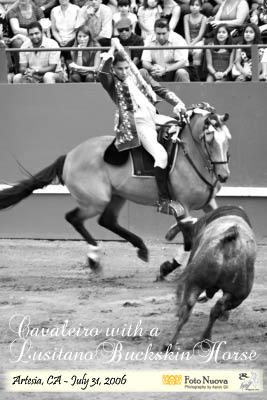
Cavaleiro going toe-to-toe with a fighting bull
The Cavaleiro is
always the first act of a bullfight. He enters the gates and waits for his
opponent to hand him his first banderilla that he will fight with. This is
a respectable gesture wishing him good luck. He then rides around the arena,
showing off the horse while exercising at the same time (like stretching out
before running). He will then dedicate his bull to either the bull owner,
horse owner, the director, or someone whom he feels like honoring that moment.
He hands them his hat and then gives the signal to the director that he is
now ready to fight.
The fight starts when the bugle gives the signal to open the gates of the
pen, and thus the first bull is released.
Without going into too much of the details, this is where man and horse both
exhibit their skillful movements, while the bull shows his bravery and gives
a good fight. The bandarilheiros are also in or partially inside the arena
waiting and watching, in case the Cavaleiro needs him. Sometimes, the bull
is not as cooperative where the expertise of a bandarilheiros is needed. Most
often, the Cavaleiro prefers to do the work themself.
The Cavaleiros objective is to place several banderillas (short and long
VTS/lances) on the bull where the Velcro has been placed (starting around
the shoulder and extending towards half way of the back). It's almost like
target, except everything has to be done just right. The first horse used
is skilled for a Saida. The first part is where the Cavaleiro observes the
bravery and movements of the bull. The cavaleiro will place around 3-6 lances
and will then change horses. At this point, the Cavaleiro should already have
an idea how the bull works and charges and can then determine which horse
he will use next.
An exceptional Cavaleiro gives the bull the advantage by allowing it to initiate
the charge first. A head-to-head action occurs until the very last second,
while the horse dodges the impact of the bull by sidestepping and wrapping
itself around the bull.
5.2 Scene 1, Act 2: FORCADOS
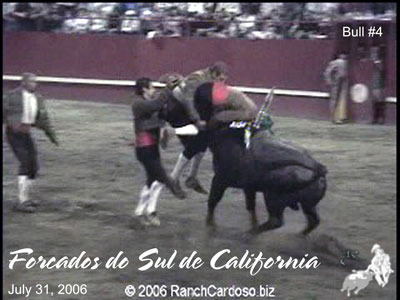
A Forcado group grabbing a bull
After the last bull has been fought by the horse rider, he will leave the
arena and then the bugle will sound again, inviting the Forcados to enter
the arena to attempt to grab the bull. They usually get only 3 attempts to
make their grabs, but sometimes the director will offer leniency and allow
them to continue for the 4th try. If the Forcados have not successfully grabbed
the bull, then the audience will be very unhappy. Once they grabbed the bull,
then it takes awhile to calm the animal down before they let go. During this
time, you can see all 8 men tugging and pulling with the bull while the bull
is trying to break free. Once they've subdued him, all but one let go, and
the one that's left is hanging onto the tail while trying to get the bull
to chase him in a circle. Once that's done, he then lets go and the crowd
cheers him on.
The bugle sounds off again letting everyone know that they are done (successful
or not).
5.2.1 Vuelta
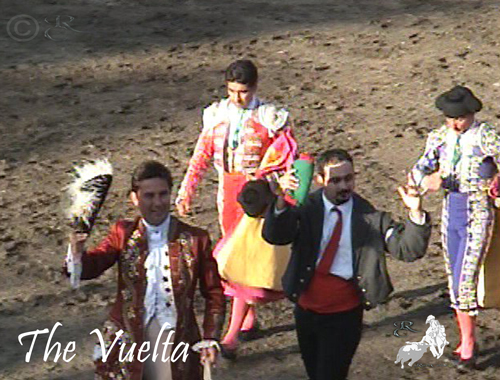
The Vuelta of the Cavaleiro and Forcado with the bandarilheiros
At this point, if both the Cavaleiro and the Forcado (who made the grab)
felt like they did good, they then walk around the arena (called a Vuelta)
where the audience show their appreciation by tossing to them roses, candies,
clothing, hats, and sometimes alcohol. Once completed, they go into the center
of the arena thanking and taking their final bow to the audience.
5.3 Scene 2, Act 1: MATADOR
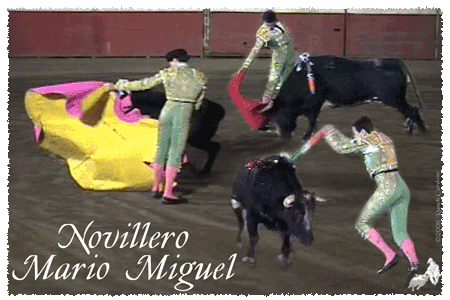
Matador exhibiting all 3 events of his act.. the Capote, Banderilla,
and the Muleta/Faena.
NOTE: at the time when this
photo was taken, Matador Mario Miguel was a Novillero (amateur)
The sounds of the bugle is heard and out comes the second bull, while the
Matador has been waiting patiently to show his artful skill.
A matador is considered to be as much an artist as a competitor. The style
and bravery of the matador is regarded as being at least as important as whether
or not he actually kills the bull. With a bloodless bullfight, everything
is the same, except the bull does not get kill, but is honored in the same
fashion.
The whole procedure is the same as the traditional Spanish style, with a
few exceptions here and there, namely what he uses at the end of his act.
Due to the event being a "bloodless bullfight", there is no pardon given to
the bull, where the bullfighter demonstrates each part throughout his scene.
5.3.1 Matador's performance
5.3.1.1 Capote
- The bull is tested for ferocity by the matador and banderilleros with
the magenta and gold capote, or dress cape.
- This initial section is called suerte de capote ("luck of the cape").
Here, there are a number of fundamental "lances" or passes that matadors
make with the cape; the most common is the "veronica".
- In the first stage, the tercio de varas ("Lances third"), the behavior
of the bull is observed by the matador by the way the bull behaves in
the arena and how he attacks the capes, when banderilleros play with
the bull with their capes. The matador is particularly interested to
know which horn the bull prefers to use, whether the bull charges in
straight or curved lines, and whether or not the bull has eyesight problems
(poor vision in one eye, for example, could result in unusual head movements).
Sometimes, the bull will head for a particular part of the ring: a querencia,
or territory. A bull trying to reach its ouerencia is often more dangerous
than a bull that is attacking the cape directly. The matador will note
the bull's peculiarities and then decide his strategy: how long the fight
will last, which passes he'll try, how close he will get to the bull.
Then the matador goes and confronts his adversary. If he performs with
art and courage, he will be rewarded with an ovation.
5.3.1.2 Banderillas
- In the next stage, the tercio de banderillas ("banderillas third"),
the Matador attempts to plant two banderillas (VTS/lances), on the bull's
flanks. The placing of the banderillas is also the last chance to correct
or fine-tune the charging tendencies of the bull. Sometimes, privilege
is given to the two banderilleros to place the banderillas. In a traditional
bullfight, if the bull proves to be extraordinarily weak or unwilling
to fight, the presidente may order, to the disgrace of the breeder, the
use of black banderillas. Because this is a bloodless bullfight, this
part is not necessary.
5.3.1.3 Muleta/Faena
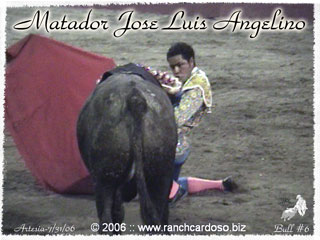
Matador making a daring pass with his red cape
- In the final stage, the tercio de muerte ("death third"), the matador
re-enters the ring alone with a small red cape or muleta in one hand
and a sword in the other. This cape is stretched with a wooden dowel
(as a batten stiffens a sail, and, in right-handed passes, the sword
as well. Having dedicated the bull to an individual or the whole audience,
he uses his cape to attract the bull in a series of passes, both demonstrating
his control over it and risking his life by getting especially close
to it. The red colour of the cape is a matter of tradition, as bulls
are actually colour blind: they attack moving objects. There are a number
of distinct styles of pass, each with its own name. The fundamental pass
with the muleta is the "natural," traditionally meaning a left-handed
pass with the muleta without the aid of the sword to prop it up.
- The faena ("work") is the entire performance with the muleta, which
is usually broken down into a series of "tandas" or "series". A typical
tanda might consist of three to five basic passes and then a finishing
touch, or "remate," such as a "pase de pecho," or "pase de desprecio." The
faena ends with a final series of passes in which the matador with a
muleta attempts to manoeuvre the bull into a position to place a banderilla
(VTS spear) between the shoulder blades. The entire part of the bulfight
with the muleta is called "el tercio de muerte" ("third of death") suerte
de muleta ("act of muleta").
6 Safety measures
A leather wrap is used to cover the bulls horns to avoid injuries on either
the horse, Cavaleiros, and the Forcados. This only prevents "serious" injuries
to the performers. Because this is a bullfight, getting hurt in the arena
is almost inevitable, especially for the Forcados. A good horsemen will ensure
the safety of the horse, otherwise, he can easily fall off.
For the Matadors, they sometimes file down the horns to make it more blunt
and less harmful, but not too much or the bull loses his balance. Besides
that, the fight for a Matador needs to be a little more challenging and exciting.
7 Ganadarias and fighting bulls
The bulls are bred as "fighting bulls" and specifically for bullfighting.
They are also treated with respect and love by the Ganadarias (bull owners/breeders)
who bring them to the fight. 15 minutes of fame and glory take at least 3
years for the bull to debut at an event. Due to the high intelligence of a
bull, they can only be run once inside an arena because every minute, they
are absorbing and learning the technique of what's going on. Each entertainer
must be quick and savvy to do what he needs to do. Otherwise, they may lose
the interest of the bull and/or the audience.
After the bull has done its deed, a group of cows brings him out of the bullfighting
arena and back inside the pen. They are not killed immediately and their future
is usually retirement in the pasture to relax, graze, and/or breed and then
they eventually go to the slaughterhouse. It can take years before they are
slaughtered. If the bull shows strength and bravery in the arena, then the
Ganadero will use him to breed more of his kind.
Every year, each Ganadaria has a "Tienta" (or "tenta"), which is basically
a mini-festa/bullfight. This is the time when the calfs and heifers are branded.
Then a few baby cows are tested to see if they have what it takes to be a
good fighting bull. This is done at the age of no less than 1-1/2 years old.
Tientas are usually small and are sometimes "invitation only" parties, and
occurs before the start of bullfighting season and sometimes after.
8 Azorean style
In the Azores,
they practice a different kind of bullfighting, in addition to the traditional
style called Touradas � corda (bullfight on a rope). This very special
event is unique to the Azores, and has been practiced since 16th Century.
From May to October there will be about 250 events on the Azores. The bull
is let loose with a very long rope around its neck, usually at the main road
in a small village. Before every bull is getting out of a wooden crate, there
will be launched a small rocket which makes a loud noise. This signal indicates,
that there is a bull on the street, and the game is ready to begin. The bull
is guided by several experienced men, keeping a grip at the rope. The whole
idea is, that the local young men now try to get as close to the bull as they
dare, teasing the bull which is getting agitated. All this game is very amusing
and dangerous, and in a way also an attempt for the local boys to impress
the local girls.
After a while the bull is taken back to the wooden crate as it arrived in,
and another rocket will be launched, announcing a break in the game. Now it's
time to move around, have something to eat, a drink ( or several ), or leave
the village.
Similar to the running with the bulls in Pamplona, Spain, but they use an
umbrella to taunt the bull, while it is tied with a rope around the neck,
held by the "puastals" on one end to keep it from injuring the people. This
is done on the streets and not inside the arena.
In California, the same is practiced, except the bull is inside the arena
rather than the streets.
Copyright � 2000-2007 MAGKON
Enterprises ™/ Ranch Cardoso™
All publications and written materials on our website are copyright protected
by each author. The information contained on our site and forum may not be
published, broadcast, rewritten or redistributed without the prior written
authority of Ranch Cardoso/MAGKON Enterprises and the individual owners of
each article.
Ranch Cardoso™ & RanchCardoso.biz™ is
copyright & owned by MAGKON Enterprises ™. All Rights Reserved
This is an article I created and started on Wikipedia in 2006. It is
no longer on Wikipedia because too many fought with me to take it off
while I fought back to keep it on. Needless to say, it was removed. So
therefore, it is copyright protected and nobody can publish, republish,
distribute, rewrite, etc, etc., without our permission. And if any permission
is granted, our copyright statement must accompany the article. This
includes but not limited to any original format that was created on Wikipedia
that is in relation to "Bloodless Bullfighting", "Portuguese
Style Bloodless Bullfighting", etc. Please click [here] to
learn more about our Terms & Conditions.
The article is still in the construction mode and more information will
be added as time permits. I hope you enjoy the path of education to bloodless
bullfighting as much as I have enjoyed putting it together. ~ Mz.
Pink Diva Webmistress
Below is one of the many original formats I started with
which is also copyright protected and cannot be used, rewritten,
republished, published, etc, etc, without prior written request and
permission from us.:
Unlike its sister discipline, the classical Spanish style bullfight,
the Portuguese style bullfighting (Portuguese tourada, corrida de touros
or tauromaquia) in Portugal, does not involve killing of the bulls in
the arena, but a little bit of blood is drawn to slow the bull down.
Bloodless Bullfighting in California is
Portuguese-style. Artful and yet skillful, bloodless bullfighting evolved
so that the Portuguese people can enjoy part of their heritage and culture
in the United States.
The difference between bloodless bullfighting in California, and the bullfighting
in Portugal is the "Velcro�" part.
To keep this sport "bloodless", one inventive Portuguese came up with the
idea of using "Velcro�". A big piece of Velcro� is placed on the
back of the bull, while the other end is placed at the tip of the banderillas
(Velcro� Tip Spear (VTS), a long stick/spear, with tassles or some kind
of a decoration around it). This mechanism replaced the banderillas which
possessed the 3-inch nails used in the classic Spanish style of bullfighting.
In Portugal, they use the banderillas, but with a pointy edge to it.
The ceremony (called the cortesias in portuguese) starts with all of the
participants entering the arena, including the bandaleiros (helpers) and
Pustals (bull herders). Here is the order of entrance during the ceremony,
as well as the fundamentals of a Portuguese style bloodless bullfight:
- First are the Forcados (aka the Suicide Squad), 8 men who
line up in the middle of the arena to grab the bull while it's charging
towards them. These men are typically very popular with the crowd.
The front man calls out to the bull, getting its attention to charge
towards him, to perform a pega de cara or pega de caras (face catch).
The front man secures himself on top of the animal's head and is quickly
aided by his fellows who surround and secure the animal until he is
subdued. Forcados were usually people from lower classes who, to this
day, practice their art through amateur associations. Modern day Forcados
range from students to professionals.
- Then enters the Matadores (professional) / Novilleros (amateur),
these guys are the ones wearing skin tight pants and a bolero jacket
called a "Suit of Light" along with pink socks. Very similar to the
Spanish matadores and most who come are from Mexico. A faena has 3
parts, including the muleta and the kill. In this case, there is no
kill. Rather than using a sword, they use the banderilla. Alongside
them are the Bandaleiros, these are their helpers while inside the
arena. They are equally brave and knowledgeable as the Matadors, because
they also have to watch their back when they are not looking. The Bandaleiros
job is to strategically place the bull where the Matador or the Cavaleiro
tells them to. They also distract the bull while the Matador or Cavaleiro
position themselves in the arena.
- Then come the Puastal(bull herders), the men who bring the
bull from the pen to the arena. These are the people who work very
closely with the Ganadero (bull breeder) and they also do most of the
preparation of the bull before an event. Preparation of the bull before
the event consists of tying the leather wrap around the horns (for
the Cavaleiros and Forcados), and cutting/filing the pointy tip of
the horn for the Matadors. Then they place the Velcro� on top of
the bull's back. They range from students to professionals.
- Cavaleiros (men on horseback) - The show stopper and crowd
pleaser, the Cavaleiros (rejoneos in Spanish style), are the people
who enter the ring with horses. The Portuguese-style costumes are typically
traditional 18th century clothing, while the Spanish-style costumes
consist of a bolero and leather chaps. They perform on horseback with
typically daring and technical movements. The horses are Portuguese
Lusitanians, specially trained for the fights. These horses are usually
skilled in dressage and exhibit their art in the arena. (The Spaniards
usually prefer Andalusians by contrast.) In modern days, it is acceptable
and common to crossbreed horses to perfect the performance of a horse.
Other breeds include Arabians, Quarterhorse, Aztecas, and Thoroughbreds,
just to name a few. Horseback bullfighters are frequently members of
old aristocratic families.
- Casino Not On Gamstop
- Migliori Casino Online
- Slot Online
- Non Gamstop Casino
- Non Gamstop Casinos UK
- Non Gamstop Casinos UK
To prevent any of the participants and horses from getting serious injuries,
the bulls' pointed horns are covered with a leather wrap for the Cavaleiros
and Forcados performances. For Matadors, they sometimes file down the
horns to make it more blunt and less harmful and to make his fight a
little more challenging and exciting.
The bulls are "fighting bulls". They are bred specifically for bullfighting.
The bulls are also treated with respect and love by the Ganadarias (bull
owners/breeders) who bring them to the fight. 15 minutes of fame and glory
take at least 3 years for the bull to debut at an event. Due to the high
intelligence of a bull, they can only be run once inside an arena because
every minute they are absorbing and learning the technique of what's going
on. Each entertainer must be quick and savvy to do what he needs to do. Otherwise,
they may lose the interest of the bull and/or the audience. After the bull
has done its deed, a group of cows brings him out of the bullfighting arena.
The future of the fighting bulls is usually retirement in the pasture to
relax, graze, and/or breed and eventually to the slaughter house. They are
not killed immediately after a fight. It can take years before they are slaughtered.
If a certain bull does well and fit the mold of a good breeder, then he is
used for breeding more of his strength.
Every year, each Ganadaria has a "Tienta" (or "tenta"), which is basically
a mini-festa/bullfight. This is the time when the calfs and heifers are branded
then a few are tested to see if they have what it takes to be a good fighting
bull. Tientas are usually small and are sometimes "invitation only" parties.
The bloodless bullfights in California are held every year, with the season
starting around April and ending mid-late October. It is usually held with
the celebration of Festas (religious festivals). It is non-profit, and most
proceeds, food, and time are donated by volunteers, committees, and festa
members of the Portuguese community. Money collected at the gate for the
bullfight pays for the performers along with other expenses. During the events,
there is a Filarmonica (Portuguese band) that plays music such as a paso
doble or a march. Portuguese food is cooked on-site and is readily available
for consumption, along with fresh baked bread and Portuguese wine (imported
or local). After a bullfight, the festivities continue with more food and
a DJ/Live band. Locations of these events are in Artesia (southern California),
throughout the Central Valley, and in some parts of Northern California.
�
� 2007 MAGKON Enterprises / Ranch Cardoso - All rights reserved.
All materials found on this website may not be published, broadcast,
rewritten, or redistributed. Learn more about our Terms & Conditions.


